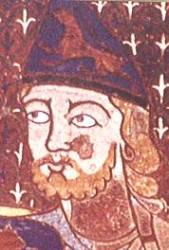
General Notes
Geoffrey V (August 24, 1113 - September 7, 1151), Count of Anjou and Maine, and later Duke of Normandy, called Le Bel ("The Fair") or "Geoffrey Plantagenet", was the father of King Henry II of England, and thus the forefather of the Plantagenet dynasty of English kings.
Geoffrey was the eldest son of Fulk, Count of Anjou and King of Jerusalem. Geoffrey's mother was Eremburge of La Flèche, heiress of Maine. Geoffrey received his nickname for the sprig of broom (= genêt plant, in French) he wore in his hat as a badge. In 1127, at Le Mans, at the age of 15 he married Empress Maud, the daughter and heiress of King Henry I of England, by his first wife, Edith of Scotland and widow of Henry V, Holy Roman Emperor. The marriage was meant to seal a peace between England/Normandy and Anjou. She was eleven years older than Geoffrey, and their marriage was a stormy one, but she survived him.
The year after the marriage Geoffrey's father left for Jerusalem (where he was to become king), leaving Geoffrey behind as count of Anjou. Chroniclers describe Geoffrey as handsome, red-headed, jovial, and a great warrior; however, Ralph of Diceto alleges that his charm concealed his cold and selfish character. When King Henry I died in 1135, Maud at once entered Normandy to claim her inheritance. The border districts submitted to her, but England chose her cousin Stephen of Blois for its king, and Normandy soon followed suit. The following year, Geoffrey gave Ambrieres, Gorron, and Chatilon-sur-Colmont to Juhel de Mayenne, on condition that he help obtain the inheritance of Geoffrey’s wife. In 1139 Maud landed in England with 140 knights, where she was beseiged at Arundel Castle by King Stephen. In the "Anarchy" which ensued, Stephen was captured at Lincoln in February, 1141, and imprisoned at Bristol. A legatine council of the English church held at Winchester in April 1141 declared Stephen deposed and proclaimed Maud "Lady of the English". Stephen was subsequently released from prison and had himself recrowned on the anniversary of his first coronation.
During 1142 and 1143, Geoffrey secured all of Normandy west and south of the Seine, and, on 14 January, 1444, he crossed the Seine and entered Rouen. He assumed the title of Duke of Normandy in the summer of 1144. In 1144, he founded an Augustine priory at Chateau-l’Ermitage in Anjou. Geoffrey held the duchy until 1149, when he and Maud conjointly ceded it to their son, Henry, which cession was formally ratified by King Louis VII of France the following year. Geoffrey also put down three baronial rebellions in Anjou, in 1129, 1135, and 1145-1151. The threat of rebellion slowed his progress in Normandy, and is one reason he could not intervene in England. In 1153, the Treaty of Westminster allowed Stephen should remain King of England for life and that Henry, the son of Geoffrey and Maud should succeed him. At Château-du-Loir, Geoffrey died suddenly on September 7, 1151, still a young man. He was buried at St. Julien's in Le Mans France. Geoffrey and Maud's children were:
Henry II of England (1133-1183)
Geoffrey, Count of Nantes (1134-1158)
William, Count of Poitou (1136-1164)
Geoffrey also had illegitimate children by an unknown mistress (or mistresses): Hamelin; Emme, who married Dafydd Ab Owain Gwynedd, Prince of North Wales; and Mary, (1181-1216) who became a nun and Abbess of Shaftesbury and who may be the poetess Marie de France.
The first reference to Norman heraldry was in 1128, when Henry I of England knighted his son-in-law Geoffrey and granted him a badge of gold lions (or leopards) on a blue background. (A gold lion may already have been Henry’s own badge.) Henry II used two gold lions and two lions on a red background are still part of the arms of Normandy. Henry's son, Richard I, added a third lion to distinguish the arms of England.
 Details of Geoffrey's family with Empress Maud
Details of Geoffrey's family with Empress Maud
Page last modified
This page is within a frameset. View the entire genealogy report of of Anjou families, or surname index of of Anjou pedigrees or report summary of Anjou heritage from 'Moore, Simpson, Ballard Family Tree - England and Scotland to Australia'.
Description of Genogram Symbols.
Copyright © 2011 GenoPro Inc. All rights reserved.
 Geoffrey of Anjou
Geoffrey of Anjou 


